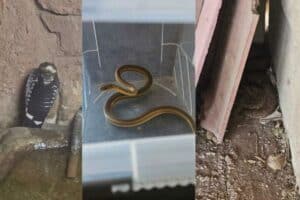The African Snakebite Institute has recently raised an alarm about the Stiletto snake (previously known as a mole adder or moladder).

As South Africans put away jerseys and heavy blankets in preparation for spring, the City of Ekurhuleni has sounded an alarm over the dangers that come with the season.
Spring is around the corner and the weather will soon be warm, says the city, but this also means snakes will be coming out to play after months of hibernation.
Snakes will be coming out in search for food.
The city has called on pet owners to be on high alert as their animals could fall prey to snakes. The city has also warned residents to refrain from killing harmless snakes should they spot them in their backyards.
The killing or capturing as pets of the harmless variety of snakes is illegal, it said.

“From mid-August until late May is snake season and a number of snakes, which are harmless to humans, such as the brown house snake, Aurora house snake, olive house snake and red-lipped snake, which are likely to be found in backyard gardens searching for food like rats and cats,” said the city in a statement.
“Due to their harmless and less defensive nature, these species tend to be easily killed or captured as pets, an illegal and punishable act if one does not have a legal permit.”
Snakes such as the puff adder and rinkhals, however, are extremely dangerous, with the puff adder known to be instinctive, slow in pace and quick to sense danger, warned the city.
“The rinkhals or ring-necked cobra is a fast moving multi feeder, which is good at faking death. It is easily identified by the two white stripes that are visible across its neck when it spreads its hood.”
The African Snakebite Institute recently raised an alarm about the Stiletto snake (previously known as a mole adder or moladder), which it says accounts for a number of snakebites during the sunny seasons, after the Mozambique spitting cobra and the puff adder.
The danger with the Stiletto, according to the institute, is that people tend to confuse them with harmless snakes and usually pick them up, with harmful consequences.
The venom of the Stiletto reportedly causes severe pain, swelling, blistering and can cause tissue damage. There is no antivenom and doctors can only treat the pain as they wait to assess the extent of the tissue damage.
Compiled by Vhahangwele Nemakonde






